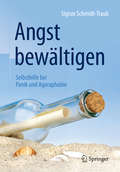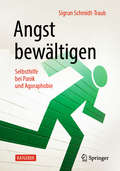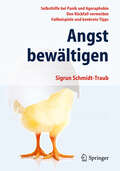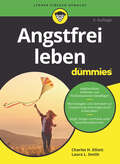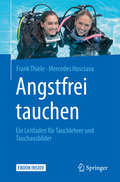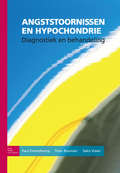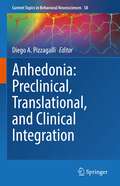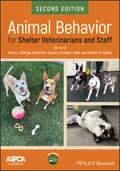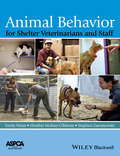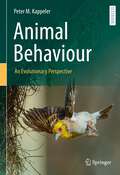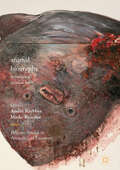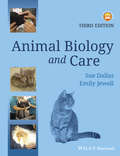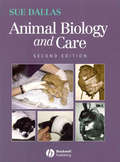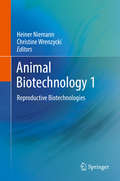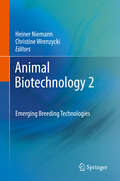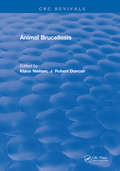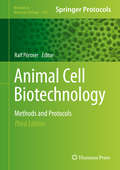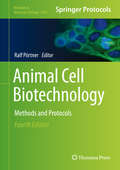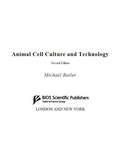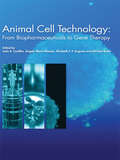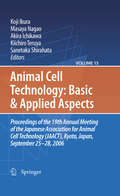- Table View
- List View
Angst bewältigen: Selbsthilfe bei Panik und Agoraphobie
by Sigrun Schmidt-TraubDieser Ratgeber hilft Betroffenen, den Teufelskreis aus Angst und Vermeidung zu durchbrechen - er leitet zur Selbsthilfe an und gibt Tipps, an wen man sich wenden kann, wenn man sich Selbsthilfe nicht zutraut oder wenn man Unterst#65533;tzung in Selbsthilfegruppen sucht. Panikartige #65533;ngste sind enorm verbreitet. Die Angstzust#65533;nde sind verbunden mit meist heftigen k#65533;rperlichen Reaktionen wie Schwindel, Herzklopfen oder Schwei#65533;ausbr#65533;chen. Sie qu#65533;len und schr#65533;nken Betroffene zusehends ein. Angstpatientinnen und -patienten bringen im Laufe der Zeit immer mehr Situationen mit ihren Angstzust#65533;nden in Verbindung und vermeiden sie. Ein Teufelskreis, der sich aber mit Hilfe verhaltenstherapeutischen Wissens und Trainings aufl#65533;sen l#65533;sst. Der Ratgeber ist von einer erfahrenen Therapeutin verst#65533;ndlich und motivierend geschrieben. Fallbeispiele zeigen M#65533;glichkeiten auf, Panikattacken besser in den Griff zu bekommen. Gut strukturiert und #65533;bersichtlich - mit vielen Beispielen; wichtige Inhalte und Tipps sind hervorgehoben.
Angst bewältigen: Selbsthilfe bei Panik und Agoraphobie
by Sigrun Schmidt-TraubDieser Ratgeber hilft Betroffenen, den Teufelskreis aus Angst und Vermeidung zu durchbrechen – er leitet zur Selbsthilfe an und gibt Tipps, an wen man sich wenden kann, wenn man sich Selbsthilfe nicht zutraut oder wenn man Unterstützung in Selbsthilfegruppen sucht. Panikartige Ängste sind enorm verbreitet. Die Angstzustände sind verbunden mit meist heftigen körperlichen Reaktionen wie Schwindel, Herzklopfen oder Schweißausbrüchen. Sie quälen und schränken Betroffene zusehends ein. Angstpatientinnen und -patienten bringen im Laufe der Zeit immer mehr Situationen mit ihren Angstzuständen in Verbindung und vermeiden sie. Ein Teufelskreis, der sich aber mit Hilfe verhaltenstherapeutischen Wissens und Trainings auflösen lässt. Der Ratgeber ist von einer erfahrenen Therapeutin verständlich und motivierend geschrieben. Fallbeispiele zeigen Möglichkeiten auf, Panikattacken besser in den Griff zu bekommen. Gut strukturiert und übersichtlich – mit vielen Beispielen; wichtige Inhalte und Tipps sind hervorgehoben. Aus dem Inhalt: Zum Verständnis von Angst – Bewältigung der Angst – Materialien zur Selbsthilfe. Die Autorin:Dr. Sigrun Schmidt-Traub, Diplom-Psychologin und -Soziologin, Verhaltenstherapeutin für Kinder, Jugendliche und Erwachsene mit über 30-jähriger ambulanter Erfahrung in eigener Praxis. Heute in der Ausbildung von angehenden Verhaltenstherapeuten als Dozentin und Supervisorin tätig. Verfasserin von zahlreichen Selbsthilfe- und Lehrbüchern zum Thema Angststörungen.
Angst bewältigen: Selbsthilfe bei Panik und Agoraphobie - Den Rückfall vermeiden - Fallbeispiele und konkrete Tipps
by Sigrun Schmidt-TraubAngst und Panik bewältigen Panikartige Ängste sind enorm verbreitet. Die Angstzustände sind verbunden mit meist heftigen körperlichen Reaktionen, wie Schwindel, Herzklopfen oder Schweißausbrüchen. Sie quälen und schränken Betroffene zusehends ein. Angstpatientinnen und -patienten bringen im Laufe der Zeit immer mehr Situationen mit ihren Angstzuständen in Verbindung und vermeiden sie. Ein Teufelskreis, der sich aber mit Hilfe verhaltenstherapeutischen Wissens und Trainings auflösen lässt. Den Teufelskreis aus Angst und Vermeidung durchbrechen Der Ratgeber ist von einer erfahrenen Therapeutin verständlich und motivierend geschrieben. Fallbeispiele zeigen Möglichkeiten auf, Panikattacken besser in den Griff zu bekommen. Gut strukturiert und übersichtlich - mit vielen Beispielen; wichtige Inhalte und Tipps sind hervorgehoben. Serviceteil: Weiterführende Literatur, Informationen zu Therapiesuche und -finanzierung, Selbsthilfegruppen etc. Sich informieren und der Angst das Angsterregende nehmen Der Ratgeber leitet zur Selbsthilfe an und gibt Tipps, an wen man sich wenden kann, wenn man sich Selbsthilfe nicht zutraut oder wenn man Unterstützung in Selbsthilfegruppen sucht.
Angst, Verlust, Trauer und die Frage nach dem Sinn: Existenzielle Themen In Psychoonkologie Und Psychotherapie - Eine Einführung (Essentials)
by Barbara LeuEine Krebsdiagnose wirft die meisten Menschen aus der Bahn und bedeutet einen tiefen und bedrohlichen Einschnitt in ihr eigenes Leben, aber auch dasjenige ihrer Angehörigen. Die Erkenntnis, dass das Leben endlich und prekär ist, kann existenzielle Ängste, tiefe Trauer und Fragen nach dem Sinn auslösen, geht es ja letztlich um die Fragen nach Sterben und Tod. Wie können involvierte Fachpersonen mit diesen letzten Fragen der „conditio humana“ umgehen, wie können sie, trotz eigener Betroffenheit, angesichts dieser existenziellen Herausforderungen tragend und hilfreich sein? Diesen Fragen geht die vorliegende Publikation mit theoretischen Inputs sowie praktischen Vorschlägen für den Aufbau einer existenziellen Grundhaltung erfolgreich nach.Die Autorin Barbara Leu ist Psychotherapeutin (systemisch und existenzielle Ausrichtung) und Psychoonkologin am Kantonsspital Aarau, Schweiz. Daneben arbeitet sie als Psychotherapeutin in einer psychiatrisch/psychologischen Gemeinschaftspraxis in Zürich, Schweiz.
Angstfrei leben für Dummies (Für Dummies)
by Laura L. Smith Charles H. ElliottViele Menschen leiden unter à ngsten - sei es Platzangst, Flugangst, Angst vor Zurückweisung, Angst vor dem Verlust des Partners oder Kindes oder Angst vor dem Verlust des Arbeitsplatzes. So unterschiedlich diese à ngste sind, eines haben sie gemeinsam: Sie beeinträchtigen das Leben der Betroffenen und ihrer Angehörigen enorm. »Angstfrei leben für Dummies« hilft mit Selbsttests und einfachen à bungen, einen Weg aus dem Teufelskreis von Angst und Sorgen zu finden. Dieser Ratgeber zeigt, wie Sie Ihren à ngsten Schritt für Schritt begegnen können und wie Sie sie schlieà lich überwinden und sich nicht mehr von ihnen beherrschen lassen.
Angstfrei tauchen: Ein Leitfaden für Tauchlehrer und Tauchausbilder
by Frank Thiele Mercedes HuscsavaPanik unter Wasser? Ein Alptraum f#65533;r Tauchsch#65533;ler und Tauchlehrer. Damit dies nicht geschieht, liefert das vorliegende Buch Tauchlehrern und Tauchausbildern wertvolle Informationen, wie man Stress oder #65533;ngsten bei Tauchsch#65533;lern erfolgreich begegnet. Die Autoren erl#65533;utern das menschliche Verhalten dabei sowohl aus wissenschaftlicher Sicht, also ,,Warum haben wir Angst?", oder ,,Wie entsteht Angst #65533;berhaupt?" und geben gleichzeitig zahlreiche Tipps, die in einer Akutsituation helfen - vor oder w#65533;hrend des Tauchgangs. Auch auf die Besonderheiten beim Tauchen mit Kindern in den verschiedenen Altersgruppen geht das Werk ein.
Angststoornissen en hypochondrie: Diagnostiek en behandeling
by P. M. G. Emmelkamp T. K. Bouman S. VisserAngststoornissen en hypochondrie is een actueel overzichtswerk, waarin op praktische wijze inzicht gegeven wordt in de classificatie (volgens de DSM-IV-TR-criteria), diagnostiek, etiologie en behandeling van angststoornissen en hypochondrie. Bij de behandeling van deze stoornissen wordt, naast een bespreking van farmacotherapie, met name aandacht besteed aan recente ontwikkelingen in de cognitieve therapie en gedragstherapie. Er zijn door de jaren heen vorderingen gemaakt op het gebied van research die implicaties hebben voor de diagnostiek en behandeling van deze stoornissen. Angststoornissen en hypochondrie gaat uitvoerig in op de problemen die zich bij het uitvoeren van de behandeling kunnen voordoen. Bovendien wordt in heldere taal een genuanceerd beeld van de huidige stand van zaken in onderzoek en theorievorming weergegeven. Het boek is voorzien van gevalsbeschrijvingen. De hoofdstukken over behandeling gaan met name uit van (cognitieve) gedragstherapeutische principes vanwege de belangrijke resultaten die daarmee geboekt zijn in de behandeling van angststoornissen en hypochondrie. Daarnaast wordt per stoornis steeds een overzicht geboden van recent onderzoek naar de behandeling met psychofarmaca. Angststoornissen en hypochondrie is een geheel herziene en geactualiseerde druk van het boek Angst, fobieën en dwang. Angststoornissen en hypochondrie is bedoeld voor psychologen, psychiaters, huisartsen, maatschappelijk werkenden en opleidingen voor deze beroepen.
Anhedonia: Preclinical, Translational, and Clinical Integration (Current Topics in Behavioral Neurosciences #58)
by Diego A. PizzagalliAnhedonia is a key symptom (and often risk factor) for various neuropsychiatric disorders, including depression, schizophrenia, substance use disorders, post-traumatic stress disorders, and Parkinson's Disease, among others. Across disorders, anhedonia has been associated with worse disease course, including poor response to pharmacological, psychological and neurostimulation treatments as well as completed suicide. Mounting evidence emerging from preclinical and translational sciences has clarified that "anhedonia" can be parsed into partially independent subcomponents, including incentive motivation, consummatory pleasure, reward learning, and effort-based decision making, pointing to distinct neurobiological substrates that could underlie anhedonic phenotypes. Taking an integrative approach that emphasizes cross-species integration and dimensional conceptualization of mental illnesses (e.g., Research Domain Criteria (RDoC)), this book represents the most comprehensive evaluation, synthesis and integration of theories and empirical findings focused on anhedonia.Organized across five parts, the handbook starts with chapters on the history, etiology, and assessments of anhedonia (Part I), followed by a section on the role of anhedonia in psychiatric and neurological disorders (Part II). Using the RDoC Matrix as a guide, Part III presents chapters synthetizing preclinical and clinical findings on different reward processing subdomains (e.g., reward responsiveness, reward valuation, reward learning). Part IV is focused on selected special topics, including historical and current perspectives on the transdiagnostic nature and importance of social anhedonia, the role of inflammation in the pathophysiology of anhedonia, the use of computational modeling to “dissect” anhedonia and improve its understanding, and links between anhedonia and suicide. Finally, Part V includes chapters on pharmacological, psychological and neurostimulation treatments for anhedonia.
Animal Abuse
by Catherine TipladyAnimal abuse affects everybody working in animal-related industries, and constitutes a significant part of veterinary caseloads and animal shelter work. Based on the author's experience as a shelter worker and veterinarian, this book provides advice and assistance to those working with animal abuse. Beginning with definitions and types of abuse that occur worldwide in domestic, industry, leisure and cultural settings, the book goes on to detail current topics of debate such as foie gras production, pedigree dog breeding, links between animal abuse and domestic violence, and the fascinating subject of veterinary forensics - the scientific investigation of instances of animal abuse. The book's practical focus is developed through interviews with people in a variety of affected roles, international case studies, and discussion of the difficulties that arise; how they can be dealt with and the mental health impacts they can have on those involved. With contributions from world-renowned experts including Phil Arkow and David Bailey, and an introduction by Clive Phillips, Animal Abuse: Helping Animals and People provides practical advice and insights into issues surrounding this emotional subject.
Animal Abuse: Helping Animals and People
by Catherine TipladyAnimal abuse affects everybody working in animal-related industries, and constitutes a significant part of veterinary caseloads and animal shelter work. Based on the author's experience as a shelter worker and veterinarian, this book provides advice and assistance to those working with animal abuse. Beginning with definitions and types of abuse that occur worldwide in domestic, industry, leisure and cultural settings, the book goes on to detail current topics of debate such as foie gras production, pedigree dog breeding, links between animal abuse and domestic violence, and the fascinating subject of veterinary forensics - the scientific investigation of instances of animal abuse. The book's practical focus is developed through interviews with people in a variety of affected roles, international case studies, and discussion of the difficulties that arise; how they can be dealt with and the mental health impacts they can have on those involved. With contributions from world-renowned experts including Phil Arkow and David Bailey, and an introduction by Clive Phillips, Animal Abuse: Helping Animals and People provides practical advice and insights into issues surrounding this emotional subject.
Animal Behavior for Shelter Veterinarians and Staff
by Pamela J. Reid Brian A. DiGangi Victoria A. Cussen Kristen A. CollinsAnimal Behavior for Shelter Veterinarians and Staff A comprehensive resource to understand the behavioral considerations for intake, management, and rehoming of dogs and cats Animal Behavior for Shelter Veterinarians and Staff provides readers with comprehensive information addressing the behavior of both animals and humans associated with the intake, management, and rehoming of dogs and cats. To aid in practical application, the book covers specific behavior considerations in both dogs and cats. Topics are separated by animal to allow for easy accessibility by professionals who are actively working in the field. Sample topics covered within the book include: The behavior issues that are a common cause of pet relinquishment Behavioral assessment, behavior modification, the integration of behavioral well-being into sheltering Welfare assessment, psychopharmacology, safety net programs, and caring for animals during long-term legal holds Equine care and caring for small mammals Animal Behavior for Shelter Veterinarians and Staff is a must-have reference for evidence-based practical tips, techniques, and protocols for everyday use in animal shelters by shelter volunteers and staff, as well as professional trainers, behaviorists, and veterinarians working with shelters.
Animal Behavior for Shelter Veterinarians and Staff
by Stephen Zawistowski Emily Weiss Heather Mohan-GibbonsAnimal Behavior for Shelter Veterinarians and Staff presents and evaluates the available research and programs that address both animal and human behaviors associated with the intake, management and rehoming of dog and cats. Introductions to dog and cat behavior relevant to any animal professional Reviews behavioral reasons for the relinquishment of dogs and cats Describes intake and assessment protocol, shelter design, training and enrichment programs that reduce stress and enhance behavioral well-being Concepts to improve the adoption process and support the human-animal bond post-adoption
Animal Behaviour: An Evolutionary Perspective
by Peter M. KappelerThis textbook presents all basic principles of animal behaviour in a clear and concise manner and illustrates them with up-to-date examples. Emphasis is placed on behavioural biology as an integrative discipline of organismic biology, focusing on the adaptive value of behaviours that facilitate resource access, predator avoidance and reproductive success and underlie parental care, all within a comprehensive presentation of social complexity. This new textbook provides a rich resource for students (and teachers) from a wide range of life science disciplines.
Animal Biography: Re-framing Animal Lives (Palgrave Studies in Animals and Literature)
by André Krebber Mieke RoscherWhile historiography is dominated by attempts that try to standardize and de-individualize the behavior of animals, history proves to be littered with records of the exceptional lives of unusual animals. This book introduces animal biography as an approach to the re-framing of animals as both objects of knowledge as well as subjects of individual lives. Taking an interdisciplinary perspective and bringing together scholars from, among others, literary, historical and cultural studies, the texts collected in this volume seek to refine animal biography as a research method and framework to studying, capturing, representing and acknowledging animal others as individuals. From Heini Hediger’s biting monitor, Hachikō and Murr to celluloid ape Caesar and the mourning of Topsy’s gruesome death, the authors discuss how animal biographies are discovered and explored through connections with humans that can be traced in archives, ethological fieldwork and novels, and probe the means of constructing animal biographies from taxidermy to film, literature and social media. Thus, they invite deeper conversations with socio-political and cultural contexts that allow animal biographies to provide narratives that reach beyond individual life stories, while experimenting with particular forms of animal biographies that might trigger animal activism and concerns for animal well-being, spur historical interest and enrich the literary imagination.
Animal Biology and Care
by Sue Dallas Emily JewellThe perfect study companion, Animal Biology and Care, 3rd Edition is specifically designed for students on animal care, animal nursing assistant and veterinary care assistant courses. This edition is fully updated with new course content, a refreshed design and colour illustrations throughout. Basic biological theory is introduced with diagrams for visual learners while photographs demonstrate the common practical procedures carried out by animal care assistants. Key features include: New content on exotic species, recognising the increasing number of these animals kept as pets. Extensive coverage of the Animal Welfare Act 2006 and recent advances in animal welfare. Written in line with course curricula, chapter summaries help you to remember key points and learning objectives. A companion website has interactive MCQs to help you test your knowledge. Divided into three main sections covering animal science and genetics, health and husbandry and nursing procedures, this book will help lay the foundations for a successful career in animal care and management!
Animal Biology and Care
by Sue DallasFollowing the success of the first edition, this new edition has been expanded to include more information on small mammals, birds and fish. Intended as a foundation text for those on animal care, nurse auxiliary and veterinary care assistant courses, it introduces essential theoretical background information and clearly outlines the practical skills necessary when embarking on the care of any animal. Designed specifically to meet the requirements of animal care, pre-veterinary nursing auxiliary and care students; Provides basic training in animal biology and care, with particular attention given to those subjects that students find difficult to understand, such as anatomy and physiology; New chapter additions on fish and birds. Clearly and simply laid out, with over 150 illustrations, Animal Biology and Care 2e will be invaluable to all those training or working in animal care.
Animal Biotechnology 1: Reproductive Biotechnologies
by Heiner Niemann Christine WrenzyckiThis two-volume textbook provides a comprehensive overview on the broad field of Animal Biotechnology with a special focus on livestock reproduction and breeding. The reader will be introduced to a variety of state-of-the-art technologies and emerging genetic tools and their applications in animal production. Also, ethics and legal aspects of animal biotechnology will be discussed and new trends and developments in the field will be critically assessed. The two-volume work is a must-have for graduate students, advanced undergraduates and researchers in the field of veterinary medicine, genetics and animal biotechnology.This first volume mainly focuses on artificial insemination, embryo transfer technologies in diverse animal species and cryopreservation of oocytes and embryos.
Animal Biotechnology 2: Emerging Breeding Technologies
by Heiner Niemann Christine WrenzyckiThis two-volume textbook provides a comprehensive overview on the broad field of Animal Biotechnology with a special focus on livestock reproduction and breeding. The reader will be introduced to a variety of state-of-the-art technologies and emerging genetic tools and their applications in animal production. Also, ethics and legal aspects of animal biotechnology will be discussed and new trends and developments in the field will be critically assessed. The two-volume work is a must-have for graduate students, advanced undergraduates and researchers in the field of veterinary medicine, genetics and animal biotechnology.This second volume is dedicated to genetic tools in animal biotechnology such as somatic cloning, transgenic technologies and the application of stem cells in livestock breeding. Also, ethics and legal aspects are discussed.
Animal Breeding and Genetics (Encyclopedia of Sustainability Science and Technology Series)
by Matthew L. SpanglerThis newly updated and revised volume of the Encyclopedia of Sustainability Science and Technology (ESST) details the role of Animal Breeding and Genetics in the sustainability of animal agriculture. The volume covers scientific principles and applications includes the current science used to advance cattle, poultry, swine,sheep, and equine populations, as well as the future role of techniques such as gene editing. International leaders in the field explain foundational concepts such as heritability, the covariance between relatives, statistical approaches to predicting the genetic merit of individuals, and the development and advancement of molecular techniques to elucidate changes in the DNA sequence that underly phenotypic variation. The use of genetic-based tools to improve animal agriculture and meet consumer demands across species is treated in detail. Readers will gain an understanding of how global livestock producers have implemented advanced genetic selection tools and used them to improve reproduction, production, efficiency, health, and sustainability. The interactions of genetics and production environments, and the genetic components of the complex interactions among animals are also discussed. The future of Animal Breeding and Genetics, including the challenges and opportunities that exist in feeding a growing world population, are addressed.
Animal Brucellosis
by Klaus NielsenThis timely publication updates and standardizes currently used diagnostic procedures for this widespread, economically costly livestock disease. It includes state-of-the-art technology, now in limited use, which will replace the conventional methodology in the near future. The volume covers research done on improved diagnostic techniques, vaccines, taxonomy, epidemiology, pathology, and basic immunology. It is an important literature review for those more established in this field and serves as a guide to researchers or diagnosticians becoming involved with this disease.
Animal Cell Biotechnology: Methods and Protocols (Methods in Molecular Biology #1104)
by Ralf PörtnerThe second edition of this book constitutes a comprehensive manual of new techniques for setting up mammalian cell lines for production of biopharmaceuticals, and for optimizing critical parameters for cell culture considering the whole cascade from lab to final production. The chapters are written by world-renowned experts and the volume's five parts reflect the processes required for different stages of production. This book is a compendium of techniques for scientists in both industrial and research laboratories that use mammalian cells for biotechnology purposes.
Animal Cell Biotechnology: Methods and Protocols (Methods in Molecular Biology #2095)
by Ralf PörtnerAnimal Cell Biotechnology: Methods and Protocols, Fourth Edition constitutes a comprehensive manual of state-of-the-art techniques for setting up mammalian cell lines and media for development of biopharmaceuticals, and optimizing critical parameters for cell culture considering the whole cascade from the lab to the final production. Special emphasis was put on model-assisted concepts. Scientists with long-refined expertise describe cutting-edge techniques for the production of therapeutic proteins and vaccines. Capturing the major advances that have occurred in both science and the technology of these biopharmaceuticals, this important book covers the powerful new techniques used in cell line and media development, optimizing process techniques and process strategies, use of model-assisted tools for process design and optimization, and in analysis. Topics include cell line and media development, techniques for process development, model-based techniques for process development, process analysis, and downstream techniques. The volume is divided into five parts that reflect the processes required for different stages of production. Written in the highly successful Methods in Molecular Biology series format, chapters include introductions to their respective topics, lists of the necessary materials and reagents, step-by-step, readily reproducible laboratory protocols, and tips on troubleshooting and avoiding known pitfalls.Animal Cell Biotechnology: Methods and Protocols, Fourth Edition provides a compendium of techniques for scientists in industrial and research laboratories that use mammalian cells for biotechnology purposes.
Animal Cell Culture and Technology (THE BASICS (Garland Science))
by Michael ButlerAnimal cell culture is an important laboratory technique in the biological and medical sciences. It has become an essential tool for the study of most biochemical and physiological processes and the use of large-scale animal cell culture has become increasingly important to the commercial production of specific compounds for the pharmaceutical industry. This book describes the basic requirements for establishing and maintaining cell cultures both in the laboratory and in large-scale operations. Minimal background knowledge of the subject is assumed and therefore it will be a readable introduction to animal cell culture for undergraduates, graduates and experienced researchers. Reflecting the latest developments and trends in the field, the new topics include the latest theory of the biological clock of cell lines, the development of improved serum-free media formulations, the increased understanding of the importance and control of protein glycosylation, and the humanization of antibodies for therapeutic use.
Animal Cell Technology: From Biopharmaceuticals to Gene Therapy
by Michael Butler Leda Castilho Ângela Maria Moraes Elisabeth F. P. AugustoAnimal Cell Technology: from Biopharmaceuticals to Gene Therapy provides a comprehensive insight into biological and engineering concepts related to mammalian and insect cell technology, as well as an overview of the applications of animal cell technology. Part 1 of the book covers the Fundamentals upon which this technology is based and covers the science underpinning the technology. Part 2 covers the Applications from the production of therapeutic proteins to gene therapy. The authors of the chapters are internationally-recognized in the field of animal cell culture research and have extensive experience in the areas covered in their respective chapters.
Animal Cell Technology: Proceedings of the 19th Annual Meeting of the Japanese Association for Animal Cell Technology (JAACT), Kyoto, Japan, September 25-28, 2006 (Animal Cell Technology: Basic & Applied Aspects #15)
by Koji Ikura Kiichiro Teruya Sanetaka Shirahata Masaya Nagao Akira IchikawaAnimal cell technology is a growing discipline of cell biology which aims not only to understand structures, functions and behaviors of differentiated animal cells, but also to ascertain their abilities to be used for industrial and medical purposes. The goal of animal cell technology includes the clonal expansion of differentiated cells, the optimization of their culture conditions, modulation of their ability to produce proteins of medical and pharmaceutical importantance, and the application of animal cells to gene therapy, artificial organs and the production of functional foods. This volume gives the readers a complete review of the present state-of-the-art and will be useful for those working in either academic environments or in the biotechnology and pharmaceutical sectors, particularly cell biologists, biochemists, molecular biologists, immunologists, biochemical engineers and all other disciplines related to animal cell culture.
